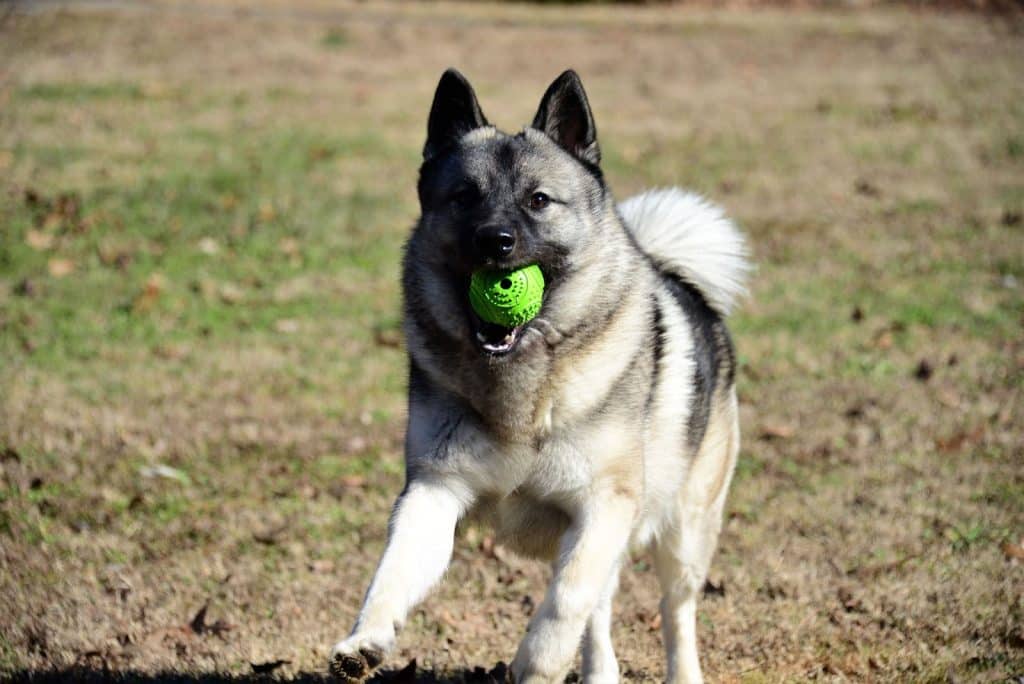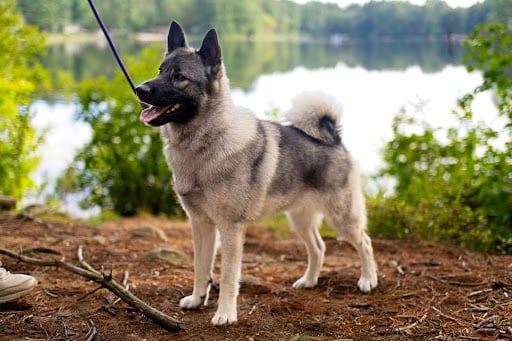
Norwegian Elkhounds (Norsk Elghund) are an ancient breed with a rich history. These rugged, versatile dogs were originally bred to hunt large game like moose.
In fact, their name means “Norwegian Moose Dog“: Elg means moose, and hund means dog.
Over the years, Norwegian Elkhounds have become a beloved household breed.
“Not only are they great sports companions, but they are sweet and cuddly and more than happy to spend the day relaxing with you on the couch,” says Holly Lewis, a member of the Board of Directors for the Norwegian Elkhound Association of America.
Read on to discover the unique traits that makes these dogs so special and learn whether they might make the right addition to your family!
Breed Characteristics
Key
- Low
- Medium
- High
- Origin: Norway
- Size:
- Weight: 48-55 pounds
- Activity level:
- Barking/howling level:
- Good with dogs: yes
- Good with kids: yes
- Good with cats:
- Shedding:
- Shedding: Seasonal
- Hair type: Double coat
- Grooming level:
- Training level:
- Drooling level:
Appearance
The Norwegian Elkhound is a sturdy northern breed. These dogs have a thick double coat that helps keep them warm across the Arctic tundra!
They have a gray coat, though the shade of gray can vary slightly, and a tail that curls tightly over the back. The muzzle, ears, and other markings are black.
You might imagine dogs that hunt moose and other big game as very large, but Norwegian Elkhounds are considered medium-sized dogs! They only stand about 20 inches high at the shoulder.
Origin And History
The Norwegian Elkhound originally came from the mountains of Scandinavia. This ancient breed appears in Norse art, and they also sailed with the Vikings.
As hunting dogs, they excel at tracking prey and use their booming bark to keep game at bay and notify their human hunting partners of their catch.
Over the centuries, they’ve evolved from hunting dogs to family companions. Though they still have an independent streak and a love of adventure, many Norwegian Elkhounds today have more toned-down characteristics compared to their hunting ancestors.
The American Kennel Association recognized the breed in 1913.
Personality And Lifestyle
“Norwegian Elkhounds are intelligent, loyal, friendly, athletic family dogs,” says Kathi Molloy, Breed Ambassador for the Norwegian Elkhound Association of America. They love to be included in your activities, she adds.
These dogs are great cuddlers and couch potatoes and can spend hours with their pet parents watching TV or reading a book. Their versatility is a huge reason why they are a popular and much-loved breed!
Norwegian Elkhounds also make good family dogs. Margaret Williamson, a core member of the Norwegian Elkhound Association of Southern California, says they’re very devoted to their families and good with kids—they just want to loved.
That said, they also have an independent streak and are highly intelligent. This combination can come across as “stubborn,” but Lewis says this label is misleading as Norwegian Elkhounds are quick to train when in the right, engaging environment.
Elkhounds are also known far and wide for their deep, booming bark, which can be a little alarming at first.
Lewis says that while these dogs are typically friendly and not normally aggressive by nature, their bear-like look, deep resounding bark, and large white teeth can discourage most unwanted visitors.
Already have other pets? Molloy says Norwegian Elkhounds do very well with other dogs and cats. Of course, it’s important to socialize Norwegian Elkhound puppies early on with other animals, just as it is with any breed!
Ideal Environment
The Norwegian Elkhound can thrive in many different environments, but their ideal home will have a few key features.
Williamson says these dogs should have plenty of room to run and play. Apartment living could work if you commit lots of time to exercise and outdoor activities, but these dogs are happiest when they have space to explore.
Elkhounds can be escape artists too, thanks to their high prey drive and sensitive noses. So, it may not be a bad idea to pick up a GPS collar before you bring home your new friend!
When it comes to exercise, Elkhounds need daily walks and hikes. They also tend to do best with activity spread out across the day, which makes them great companions for active families.
Since these dogs prefer to spend time around their families, they may not make a great match for busier people or homes that stay empty most of the day.

Training
Elkhounds are both intelligent and headstrong, which means you’ll need a good sense of humor and plenty of patience. They can be challenging to train initially, but they learn quickly when in a fun and engaging environment.
With consistent and positive dog training, Elkhounds can thrive in a variety of canine sports, including:
- Agility
- Barn Hunt
- Obedience
- Rally
- Dog shows
- Herding
- Tracking
- Scent work
- Hunting
Nancy Tyler, president of the Norwegian Elkhound Club of the Potomac Valley, says Elkhounds do a lot of different types of therapy work, too. “Personally, my Elkhound served with the dogs for comfort and support to the families of the 9/11 bombing of the Pentagon.”
Early socialization and consistent, positive training are essential to help your Elkhound grow into a well-mannered adult.
“It is important to get pups off to the right start in life by socializing them and making all their experiences positive ones,” Williamson says.
Grooming Needs
Before you get a Norwegian Elkhound, you may want to get better acquainted with your vacuum cleaner! These dogs have a magnificent double coat that can keep them protected during hot summers and cold, wet winters—but a lot of that coat will end up on your floor!
“Norwegian Elkhounds shed once a year for males and about every six months for females, based on heat cycles,” Williamson says.
A good brushing every week will help keep your dog’s coat in check and make shedding a little more manageable. Williamson says using a fine-tooth comb or rake can help you stay ahead of the shedding.
Bathing can help loosen and remove dead hair too, especially during a major shedding season.
“The Elkhound, shown in his natural condition, requires no trimming or stripping—even for show purposes,” Lewis explains.
So, you’ll spend a lot of time brushing but not much else!
As Williamson puts it, regular grooming is a breeze as long as you’re consistent. “If you comb or brush your Norwegian Elkhound weekly, their coat will be relatively easy to maintain.”
Health
Norwegian Elkhounds were purpose-bred dogs for a very long time, and they’re generally robust and hearty. Still, they do have a few potential health issues it’s important to keep in mind.
Elkhounds can be prone to certain genetic conditions, like hip dysplasia and cataracts.
Additionally, Williamson says this breed can easily gain weight if pet parents are not careful with food and snacks. “If you are training your dog and using reward-based treats, you need to be aware of the amount you are feeding and act accordingly.”
Whenever you bring home a new pet, it’s always a good idea to consider a pet insurance plan to help with preventive care and emergency costs.
Alternative Dog Breeds To Consider
Perhaps the Norwegian Elkhound has caught your eye, but you aren’t sure they’re the right dog for you—or you don’t know whether you can find one to adopt!
Some dogs with similar traits or appearance include:
- Siberian Husky: Though much larger than Norwegian Elkhounds, Siberian Huskies are much easier to find and have a slightly similar appearance.
- Alaskan Malamute: These dogs are best for active families who have plenty of time for exercise and grooming the Malamute’s thick coat.
- German Shepherd: If you’re all right with large breed dogs, German Shepherds make intelligent, devoted companions. They need frequent exercise and plenty of mental stimulation, along with regular grooming—but they’re fairly easy to find in most areas.
Getting A Norwegian Elkhound
While you can occasionally find Norwegian Elkhounds through rescues, their rarity makes this challenging. In many cases, you’ll need to find a breeder if you’d like to adopt one of these dogs.
The Norwegian Elkhound Association of America runs a rescue organization exclusively for this breed. They can also help you find a dog from a breeder.
When going through a registered breeder, you can expect to spend between $1500-$2500, at minimum, on a puppy whose parents and grandparents have been health tested and registered, Molloy says.
When choosing a breeder, it’s important to check for the following:
- Health clearances: Reputable breeders will provide health documentation on common issues like hip dysplasia. Most will also provide a puppy’s health records, which should show that the puppy received a vet checkup and their first vaccinations.
- Reputation: A breeder’s reputation means a lot. Look for recommendations from breed clubs or associations, like the Norwegian Elkhound Association of America.
- Breeding practices: Most breeders focus on one or two breeds. If your breeder sells several breeds, proceed with caution. Another red flag is multiple litters. Very few breeders will have several litters at once.
- Living conditions: Always ask to see where the mother and puppies live. The environment should be clean and safe.
- Socialization: Puppies need socialization from a relatively young age. Ask the breeder what steps they’ve taken to help the puppy become acquainted with home life, people, and other animals.
- Contracts: Breeders care about how their puppies are treated, so many will require buyers to sign contracts.
- Support: Quality breeders often provide support to buyers. For example, they might provide a “starting kit” for your puppy.
Because Norwegian Elkhounds are rare, you may need to exercise some patience if you have your heart set on this dog—but their loving and fun nature will make your wait worth it!
Resources
- About Elkhounds. (n.d.). https://neaa.wpengine.com/about-elkhounds/#viking-history
- Breeds by year recognized. (n.d.). https://www.akc.org/press-center/articles-resources/facts-and-stats/breeds-year-recognized
- Lewis, H. (2024). Personal interview.
- Molloy, K. (2024). Personal interview.
- Official standard of the Norwegian Elkhound. (1989). https://images.akc.org/pdf/breeds/standards/NorwegianElkhound.pdf
- Williamson, M. (2024). Personal interview.
- Tyler, N. (2024). Personal interview.